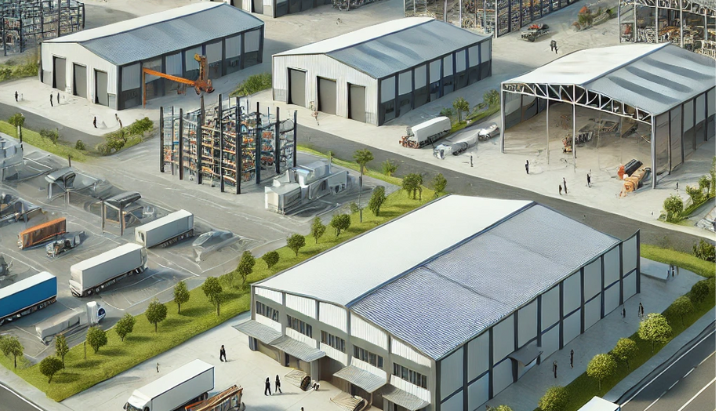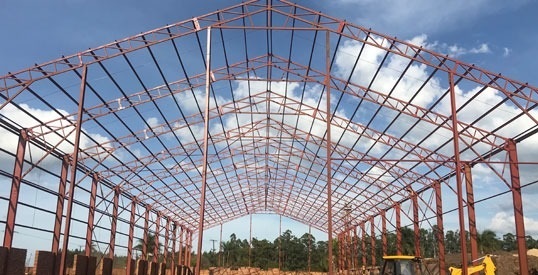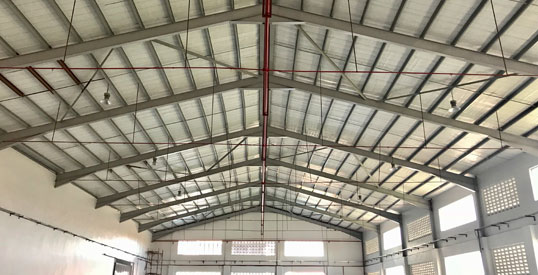Pre-Engineered Buildings for Various Industries

Pre-Engineered Buildings (PEB) have revolutionized the construction industry by offering a versatile, cost-effective, and time-efficient alternative to traditional building methods. Initially popular for industrial use, PEBs have expanded into various sectors, from commercial and residential to institutional and agricultural. This article explores the diverse applications of PEBs across different industries, highlighting their benefits and potential for future growth.
Applications of PEBs in the Industrial Sector
Manufacturing Plants
PEBs are ideal for large-scale manufacturing facilities due to their ability to create expansive, column-free spaces. Industries such as automotive, electronics, and textiles commonly use PEBs for their manufacturing plants, benefiting from the speed of construction and cost efficiency.
Warehouses and Storage Facilities
Warehouses require large, unobstructed spaces for efficient storage and logistics operations. PEBs provide the perfect solution with their wide spans and high ceilings, allowing for maximum storage capacity. Their scalability also means that warehouses can be easily expanded as business needs grow.
Workshops and Factories
Workshops and factories benefit from the durability and cost-effectiveness of PEBs. The ability to customize the building design to meet specific industrial requirements, such as machinery layout and workflow, makes PEBs a preferred choice in the industrial sector.

PEBs in the Commercial Sector
Retail Stores and Shopping Malls
PEBs are increasingly used in the commercial sector for retail stores and shopping malls. Their aesthetic flexibility allows for modern, attractive designs, while their structural efficiency supports large open spaces necessary for retail environments. PEBs also enable rapid construction, minimizing downtime for businesses.
Office Buildings
The use of PEBs in office buildings is gaining popularity due to the demand for quick construction and modern, energy-efficient designs. PEBs can be customized to create contemporary office spaces that are both functional and sustainable, reducing operating costs over time.
Service Centers and Auto Showrooms
Service centers and auto showrooms require a combination of visual appeal and practical design. PEBs offer both, with customizable layouts that can accommodate service bays, display areas, and customer spaces, all within a visually striking structure.
PEBs in the Agricultural Sector
Farm Buildings and Barns
Agricultural structures like barns, stables, and storage sheds benefit from the durability and cost-effectiveness of PEB. These buildings can be customized to meet the specific needs of different types of farming operations, from livestock housing to equipment storage.
Cold Storage Facilities
Temperature control is crucial in agricultural storage, particularly for perishable goods. PEBs can be designed with advanced insulation and climate control systems, making them ideal for cold storage facilities that maintain specific temperature ranges to preserve produce.
Greenhouses
Greenhouses made from PEBs offer the advantage of creating controlled environments tailored to specific plant growth needs. The flexibility in design allows for customization in terms of ventilation, heating, and layout, ensuring optimal growing conditions.

PEBs in the Institutional Sector
Educational Facilities
Schools and universities are turning to PEBs for their ability to provide durable, low-maintenance buildings that can be constructed quickly. Whether it’s classrooms, auditoriums, or sports facilities, PEBs offer flexible designs that meet the varied needs of educational institutions.
Healthcare Buildings
In the healthcare sector, PEBs are used to construct hospitals, clinics, and other medical facilities. Their ability to be designed to stringent hygiene and safety standards, along with the speed of construction, makes them ideal for healthcare applications where time and quality are critical.
Community Centers and Recreational Facilities
PEBs are a popular choice for community centers and recreational facilities due to their versatility and cost-effectiveness. These buildings can be easily adapted for multiple uses, from sports halls to event spaces, providing communities with durable and functional public structures.
PEBs in the Infrastructure Sector
Airports and Hangars
The aviation industry relies on PEB for airports and aircraft hangars large-span structures. The ability to create expansive, column-free spaces is particularly advantageous for these applications, where the clear span is crucial for accommodating aircraft and facilitating smooth operations. PEBs offer both the strength and durability needed to withstand the demands of airport and hangar environments, making them a preferred choice in the infrastructure sector.
Transportation Hubs
Transportation hubs, including bus and train stations, benefit from the efficiency and adaptability of PEBs. These buildings often require large, open areas for passenger flow and operational facilities. PEBs allow for the rapid construction of these hubs, ensuring that they can be up and running quickly to meet the needs of growing urban populations.
Bridges and Flyovers
While traditionally associated with vertical structures, PEBs are also finding innovative applications in the construction of bridges and flyovers. The pre-engineering process allows for precise fabrication of components, leading to faster assembly and reduced construction timelines. The durability of PEBs ensures that these critical infrastructure elements meet the necessary safety and longevity standards.
PEBs in the Residential Sector
Multi-Family Housing
PEBs are increasingly being used for multi-family housing developments, such as apartment complexes and condominiums. The cost-effectiveness and speed of construction make PEBs an attractive option for developers looking to meet the growing demand for affordable housing. PEBs also offer flexibility in design, allowing for the integration of modern amenities and aesthetic features.
Individual Homes
For individual home construction, PEBs provide a fast and durable solution. Homeowners can benefit from the quick assembly process, which reduces construction time and costs. Additionally, PEB homes can be designed to meet specific aesthetic preferences, offering a blend of traditional and modern architectural styles.
Mixed-Use Developments
Mixed-use developments, which combine residential, commercial, and recreational spaces, are ideal candidates for PEB construction. The flexibility of PEBs allows for the seamless integration of different building types within a single development, optimizing land use and enhancing the overall functionality of the space.
Innovative Applications of PEBs
Sports Complexes and Stadiums
PEBs are well-suited for sports complexes and stadiums due to their ability to create large, open spaces with unobstructed views. These structures can be customized to accommodate specific sports, from indoor arenas to outdoor stadiums, offering both functionality and aesthetic appeal.
Exhibition Halls and Convention Centers
Exhibition halls and convention centers require versatile, open spaces that can be easily reconfigured for different events. PEBs provide the structural integrity needed for these large-scale venues while allowing for quick setup and dismantling of exhibits. The adaptability of PEBs makes them an excellent choice for these dynamic environments.
Data Centers
Data centers require buildings that are secure, energy-efficient, and capable of supporting large amounts of equipment. PEBs are increasingly being used in the construction of data centers due to their ability to provide customized, scalable solutions. The precise engineering of PEBs ensures that these facilities meet the stringent requirements of data security and environmental control.
Sustainability and PEBs
Eco-Friendly Materials and Designs
Sustainability is a growing concern in the construction industry, and PEBs are at the forefront of eco-friendly building practices. The use of recyclable materials, such as steel, and the reduction of construction waste contribute to the environmental benefits of PEBs. Additionally, PEBs can be designed with energy efficiency in mind, incorporating features such as natural lighting and ventilation.
Long-Term Environmental Benefits
Over the lifespan of a PEB, the environmental impact is significantly lower compared to traditional construction methods. The durability and low maintenance requirements of PEBs reduce the need for frequent repairs or renovations, minimizing the building’s carbon footprint. As more industries seek sustainable building solutions, the long-term environmental benefits of PEBs will continue to be a major selling point.
Conclusion
Pre-Engineered Buildings have proven to be a versatile and cost-effective solution across a wide range of industries. From industrial manufacturing plants and warehouses to commercial office buildings, agricultural facilities, and residential housing, PEBs offer numerous benefits, including rapid construction, design flexibility, and sustainability. As the demand for efficient and environmentally friendly construction methods continues to grow, the applications of PEBs are likely to expand even further. Whether you’re in the industrial, commercial, institutional, or residential sector, exploring PEB options could provide the perfect solution for your building needs.
FAQs
What are the main advantages of using PEBs in industrial applications?
PEBs offer rapid construction, cost-effectiveness, and the ability to create large, open spaces ideal for industrial use. They are also highly customizable to meet specific industrial requirements.
Can PEBs be used for residential buildings?
Yes, PEBs are increasingly used in residential construction, particularly for multi-family housing and individual homes. They offer quick assembly, durability, and design flexibility.
What industries benefit the most from using PEBs?
Industries such as manufacturing, warehousing, agriculture, commercial retail, and institutional sectors benefit significantly from the use of PEBs due to their efficiency, flexibility, and cost savings.
Are PEBs suitable for customized building designs?
Yes, PEBs are highly customizable, allowing for a wide range of design options that can be tailored to specific project needs, whether for industrial, commercial, residential, or institutional purposes.
- Which Steel Cable Tray Type is Best? A Look at Perforated, Ladder, Wire Mesh & Flexible Trays
- The Impact of Temperature Variations on Cold Storage Warehouses in Different Cities of Uganda
- Uganda’s Rising Demand for Cold Storage Builders in the Logistics Industry
- The Impact of Factory Shed Layout on Workflow Efficiency
- Custom Window Fabrication: Different Types, Applications, Benefits for Residential and Commercial Spaces
